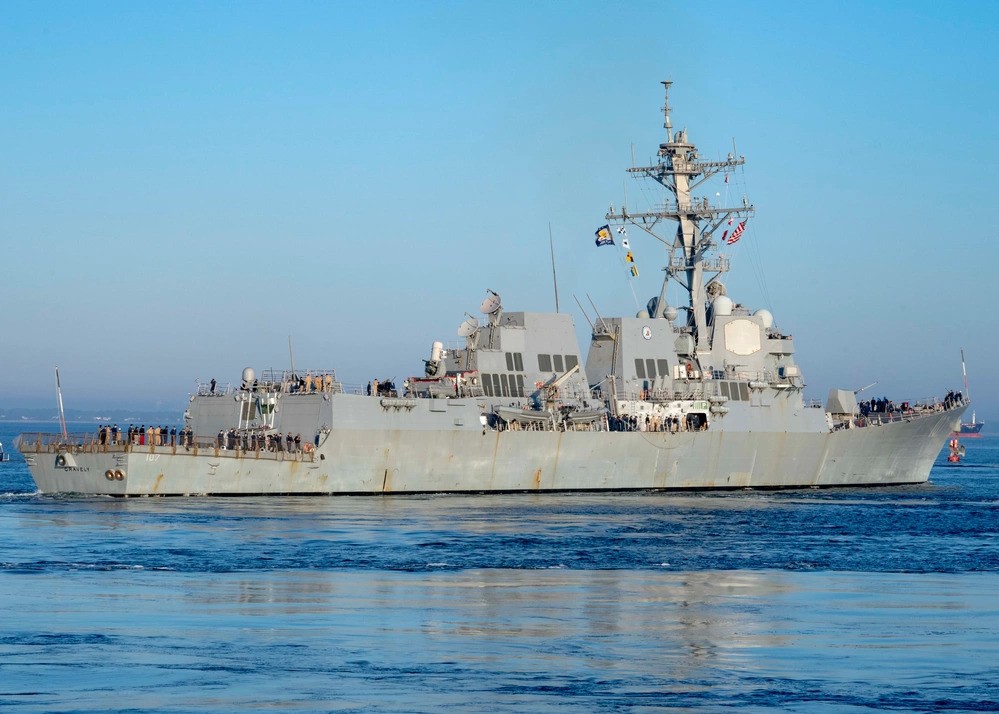For the first time since they began swatting down Houthi missiles and drones fired into the Red Sea region, a U.S. warship had to use its Mark 15 Phalanx Close-In Weapon System (CIWS) against an incoming threat, CNN reported. Taken at face value, this is a very unsettling revelation as Phalanx’s engagement envelope is very close to the ship and is seen as a ‘last ditch’ point defense system. How the missile managed to penetrate the Aegis destroyer’s defenses is unclear at this time.
The Arleigh Burke class guided missile destroyer USS Gravely shot down a Houthi anti-ship cruise missile launched into the Red Sea with its CIWS on Tuesday, according to CNN. CENTCOM said that there was no injuries or damage from that incident, however that missile came within a mile of the Gravely, according to CNN.
“In the past, these missiles have been intercepted by U.S. destroyers in the area at a range of eight miles or more,” the officials told CNN. “But the USS Gravely had to use its Close-In Weapon System (CIWS) for the first time since the U.S. began intercepting the Houthi missiles late last year, which ultimately succeeded in downing the missile,” officials told CNN.

A U.S. defense official declined to discuss with The War Zone how the Gravely shot down the missile, citing operational security concerns.
Arleigh Burke class vessels like the Gravely are equipped with one or two Phalanxes, the Gravely, a Flight IIA Burke, has one mounted amidships atop its rear superstructure. The Mk15 Phalanx uses self-contained search and engagement radars, as well as electro-optical and infrared cameras, to direct its 20mm M61 Vulcan cannon that fires tungsten-tipped rounds to shred incoming missiles, boats, and drones at 4,500 rounds per minute.

While this is the first reported case of a Navy warship using its CIWS against Houthi threats, there have been numerous other engagements. Since October 19, 2023, Navy Arleigh Burke class destroyers and aircraft have shot down at least 68 drones and 19 anti-ship missiles (a mixture of ballistic and cruise types) launched by the Houthis, according to CENTCOM media releases. A single Burke, the USS Carney, is alone responsible for at least 38 of these intercepts. It shot down another anti-ship ballistic missile in the Gulf of Aden just today, a U.S. defense official told The War Zone, without specifying how.

British and French forces, including the French Navy’s Aquitaine class frigate Languedoc (a FREMM type), and the U.K.’s Type 45 destroyer HMS Diamond have downed additional Houthi drones. Many more Houthis missiles and drones were not intercepted in that same time span, some striking commercial ships passing through the region.
We don’t know the exact mix of missiles that Navy Arleigh Burke destroyers have been employing to shoot down Houthi missiles and drones. To date, the only type of ship-launched missile that has been confirmed to have been employed in the course of these operations is the SM-2, but others have likely been used, as well.
Also unknown is why the Gravely had to use its CIWS as opposed to it air defense missiles, but regardless, that is a last line of defense method for taking out an approaching missile. Considering the nature of this engagement, decoys and countermeasures, including physical and electronic warfare types, were likely employed, as well.
Given the increasing threat from and drones and crusie missiles, the Navy is pushing to integrate more directed energy weapons, including various tiers of laser and high-power microwave types, across its surface fleets. These weapons can provide additional layers of defense and magazine depth for dealing with close-in threats.
For now, however, the Navy has to rely on what it has on hand. CENTCOM will no doubt examine how and why the Gravely had to use its CIWS. If and when we find out the details, we will provide them.
Update: 9:49 PM Eastern –
CENTCOM released additional information about the Carney’s engagement with Houthi aerial threats today. The command said it shot down a Houthi anti-ship ballistic missile fired toward the Gulf of Aden at 8:30 p.m. local time and three Iranian drones in its vicinity at 9:10 p.m. local time.
Update: 11:25 PM Eastern –
CENTCOM announces new U.S. strikes on a Houthi drone site in Yemen.
U.S. forces identified a Houthi “UAV ground control station and one-way attack UAVs in Houthi-controlled areas of Yemen and determined that they presented an imminent threat to merchant vessels and the U.S. Navy ships in the region,” the command said in its media release.
“U.S. forces subsequently struck and destroyed the UAV ground control station and 10 one-way attack UAVs in self-defense.”
The strike “will protect freedom of navigation and make international waters safer and more secure for U.S. Navy vessels and merchant vessels.”
Contact the author: howard@thewarzone.com
